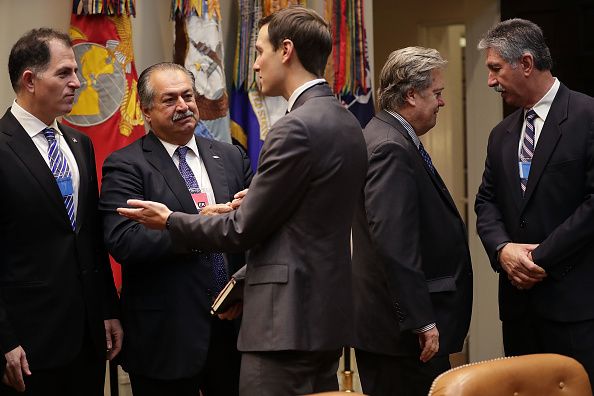
Donald Trump may be doing all he can to support American manufacturers. But, as the experiences of Mario Longhi indicate, that doesn’t necessarily mean CEOs have been lent a free ride.
Late yesterday, the U.S. Steel CEO and member of the president’s manufacturing advisory committee stood down after less than four years in the role. The announcement came a little over two weeks after Longhi handed down a surprise quarterly loss, despite relatively buoyant steel prices, that triggered a deep fall in the company’s stock.
American steel manufacturers are among companies that Trump has specifically singled out for support, as they grapple with a flood of new supplies from lower-cost manufacturing centers such as China. To be sure, steel prices have risen this year as previous government crackdowns on product dumping eased a supply glut and the local economy continued to improve.
Trump’s election heralded a potentially even better deal for the industry, though the administration has struggled to pass policies in Congress, slowing Trump’s protectionist agenda. The president also has failed to secure funding for a proposed wall along the Mexican border, which would benefit materials and building companies involved in its construction.
“U.S. Steel employees dug in, tackled every challenge and never stopped looking for ways to improve everything they could control. I am fortunate to have spent 5 years with them.”
Longhi visited Trump in the Oval Office last month and stood beside the president when he announced a probe into steel imports. “His impact was felt across our company and the steel industry through his efforts in Washington, D.C., to combat unfair trade and create a level playing field,” U.S. Steel chairman David Sutherland said of Longhi’s departure.
Developments in Washington, however, appear to have little to do with Longhi’s departure, which instead offers a lesson on how to manage spending during a downturn.
Last month, U.S. Steel booked a net loss of $180 million after it increased spending on assets it had neglected when prices were in the doldrums. The extra investment, criticized by analysts as coming too late, prevented it on capitalizing on recent steel-price rises. Shares in the company plunged by as much as 26% that day, wiping out much of the gains experienced on the back of Trump’s election in November.
Longhi, who joined the company in 2012, has been replaced by COO David Burritt. He will remain on the board of directors and provide transitional support to Burritt until his official retirement on June 30. U.S. Steel shares, despite recent falls, are 17% stronger than they were when Longhi was promoted to CEO from COO on September 1, 2013.
“I am proud of the progress we have made, which solely resides on the people of this company,” Longhi said. “U.S. Steel employees dug in, tackled every challenge and never stopped looking for ways to improve everything they could control. I am fortunate to have spent five years working with them.”

Chief Executive Group exists to improve the performance of U.S. CEOs, senior executives and public-company directors, helping you grow your companies, build your communities and strengthen society. Learn more at chiefexecutivegroup.com.
0

1:00 - 5:00 pm
Over 70% of Executives Surveyed Agree: Many Strategic Planning Efforts Lack Systematic Approach Tips for Enhancing Your Strategic Planning Process
Executives expressed frustration with their current strategic planning process. Issues include:
Steve Rutan and Denise Harrison have put together an afternoon workshop that will provide the tools you need to address these concerns. They have worked with hundreds of executives to develop a systematic approach that will enable your team to make better decisions during strategic planning. Steve and Denise will walk you through exercises for prioritizing your lists and steps that will reset and reinvigorate your process. This will be a hands-on workshop that will enable you to think about your business as you use the tools that are being presented. If you are ready for a Strategic Planning tune-up, select this workshop in your registration form. The additional fee of $695 will be added to your total.

2:00 - 5:00 pm
Female leaders face the same issues all leaders do, but they often face additional challenges too. In this peer session, we will facilitate a discussion of best practices and how to overcome common barriers to help women leaders be more effective within and outside their organizations.
Limited space available.

10:30 - 5:00 pm
General’s Retreat at Hermitage Golf Course
Sponsored by UBS
General’s Retreat, built in 1986 with architect Gary Roger Baird, has been voted the “Best Golf Course in Nashville” and is a “must play” when visiting the Nashville, Tennessee area. With the beautiful setting along the Cumberland River, golfers of all capabilities will thoroughly enjoy the golf, scenery and hospitality.
The golf outing fee includes transportation to and from the hotel, greens/cart fees, use of practice facilities, and boxed lunch. The bus will leave the hotel at 10:30 am for a noon shotgun start and return to the hotel after the cocktail reception following the completion of the round.